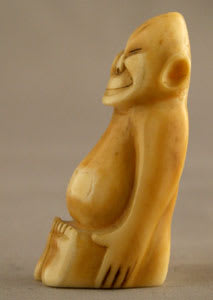Miniature Walrus Tusk Sculpture, 19th Century CE
Walrus Tusk
0.75 x 2 x 1
CK.0185
The settling of arctic North America is a human miracle of the highest magnitude. The continent’s northern rim features a desolation of mountain ranges, tundra, icy beaches and snowfields without...
The settling of arctic North America is a human miracle of the highest magnitude. The continent’s northern rim features a desolation of mountain ranges, tundra, icy beaches and snowfields without horizon. It is uniform only in its cold, its winter dark and its total disregard for the poorly equipped and inhospitable region dominated by sea and ice. The secret of the arctic peoples success in this region lay in their incredible adaptation to these seemingly harsh circumstances, for however grim their earthly realm appears to us, it is one of the world’s riches areas in available natural bounty. The region supports abundant sea life, a large variety of birds, as well as numerous species of land animals. The arctic people utilized these resources not only for subsistence but also for creative expression, as revealed in this sensitively sculpted figure.
A broad grin dominates the face of this figurine. Such is the extent of the smile that the eyes have been tightly closed and appear as two diagonal lines. The pointed shaped of the figure’s head recalls the inherent form of the tusk from which it has been carved. The figure sits with his arms stretched out along his sides, hands gripping thighs. The legs have been dramatically foreshortened due to the shape of the material. Diminutive in scale, fitting easily in the palm of one’s hand, such a figure would have likely served a religious or ceremonial function, or perhaps represents an ancestor.
A broad grin dominates the face of this figurine. Such is the extent of the smile that the eyes have been tightly closed and appear as two diagonal lines. The pointed shaped of the figure’s head recalls the inherent form of the tusk from which it has been carved. The figure sits with his arms stretched out along his sides, hands gripping thighs. The legs have been dramatically foreshortened due to the shape of the material. Diminutive in scale, fitting easily in the palm of one’s hand, such a figure would have likely served a religious or ceremonial function, or perhaps represents an ancestor.



